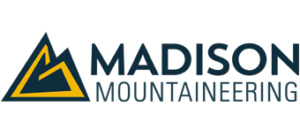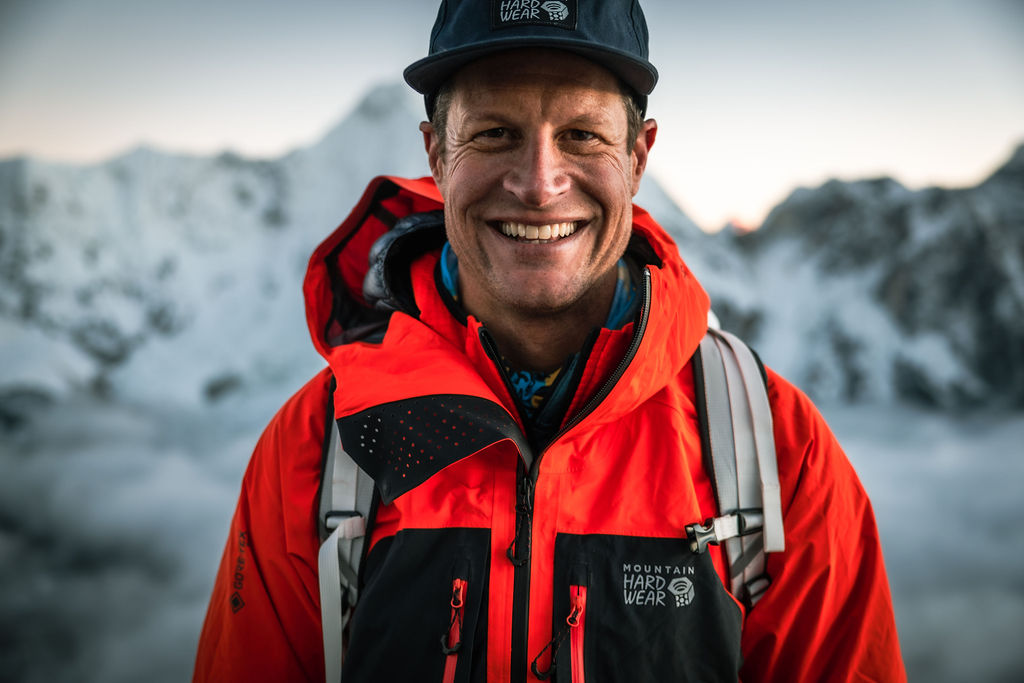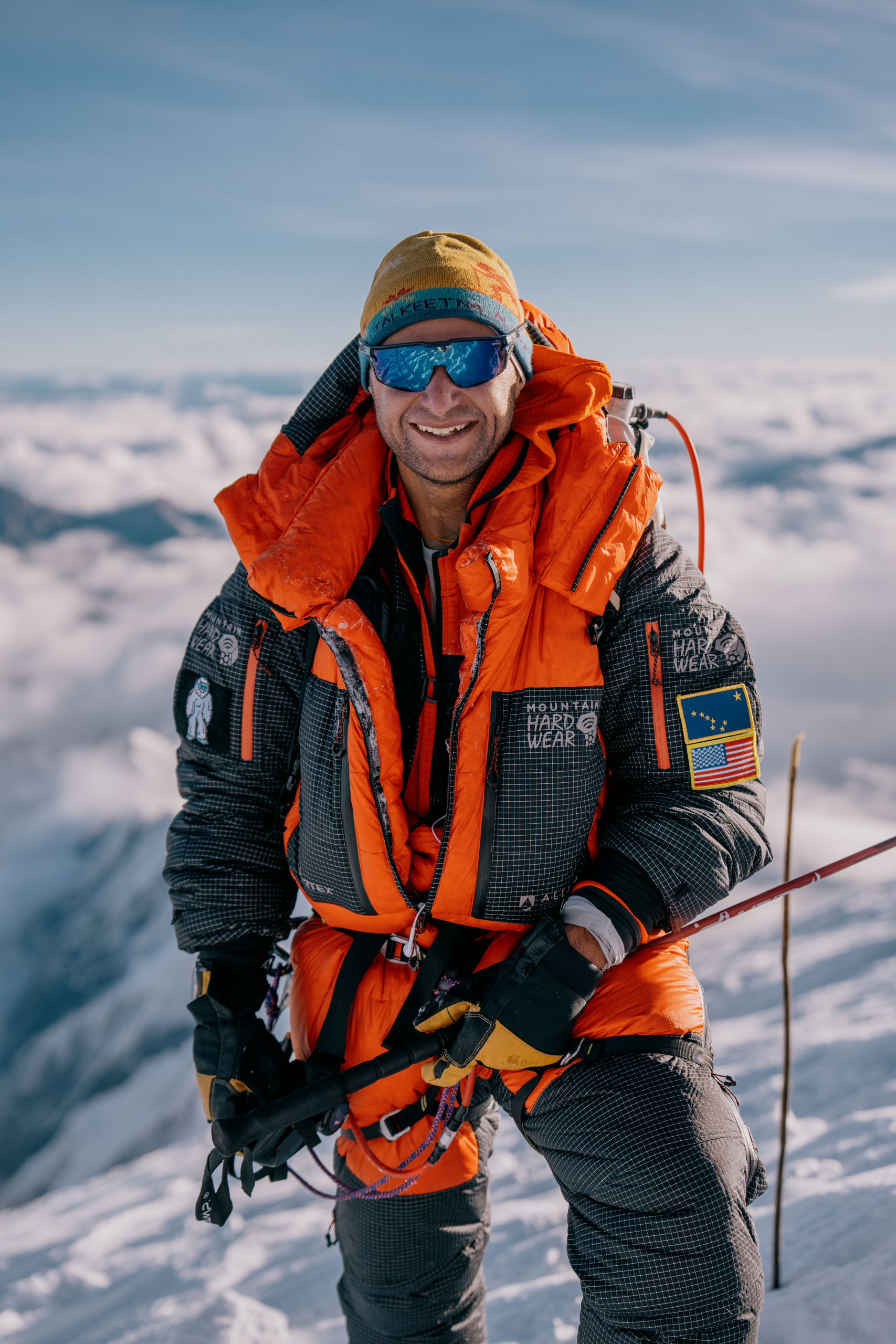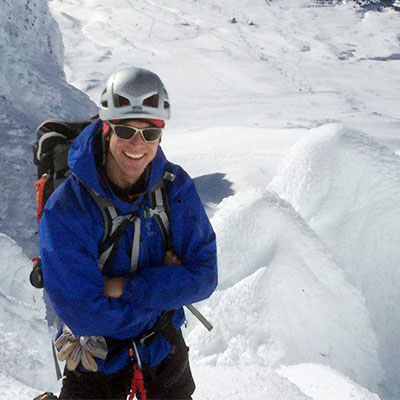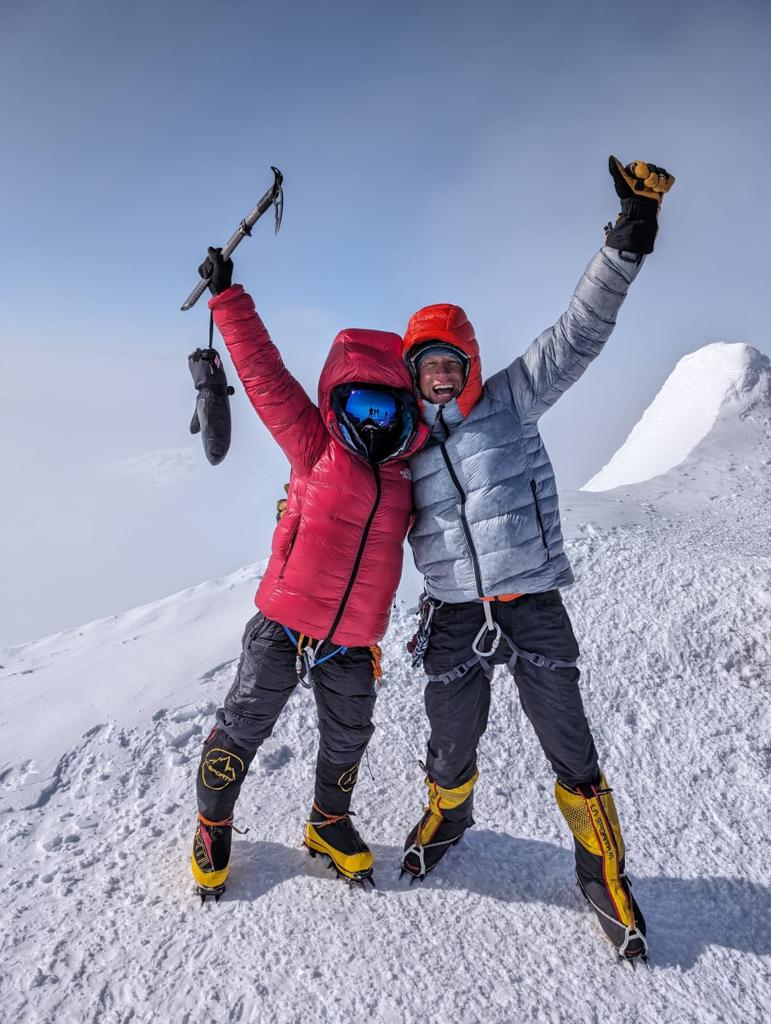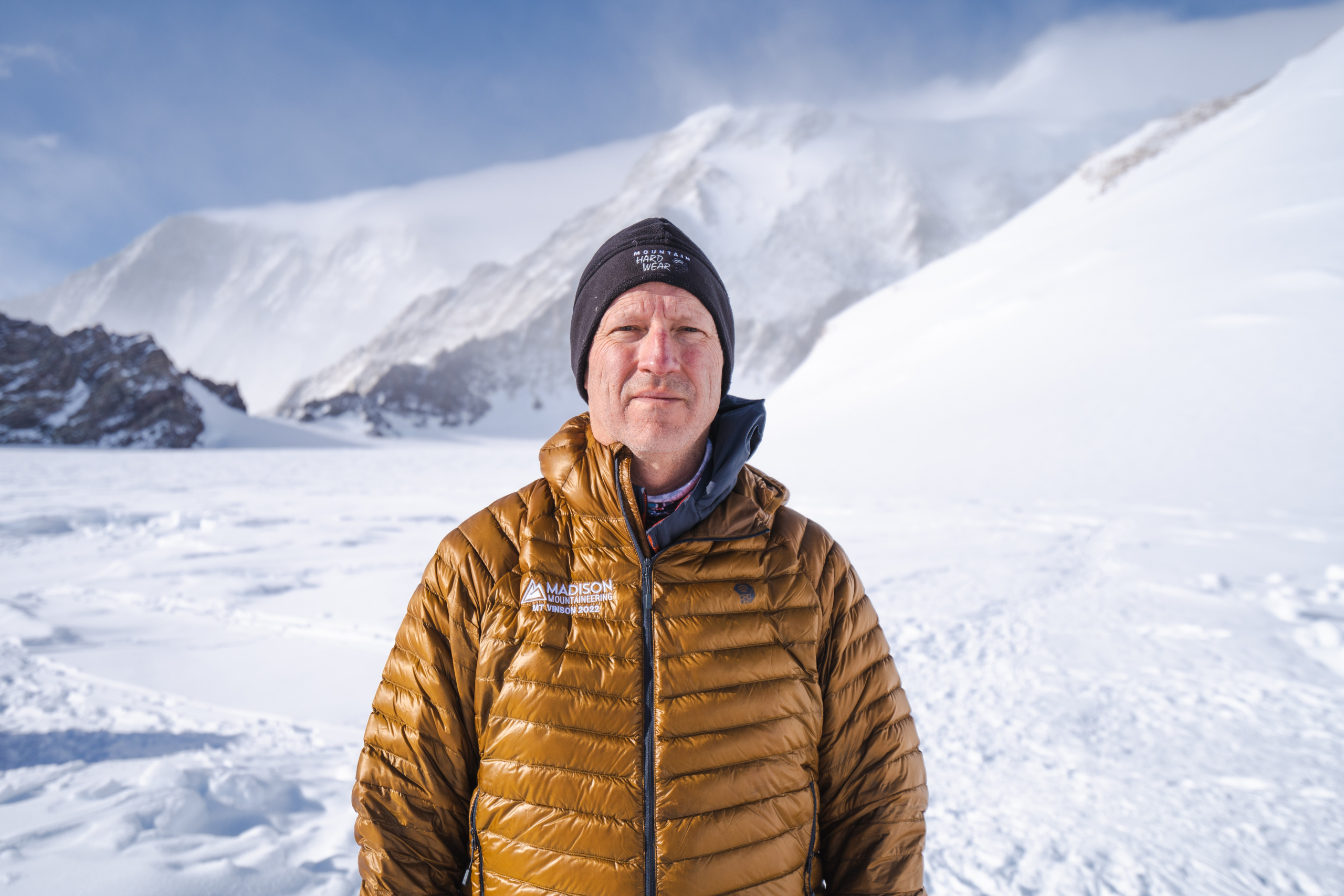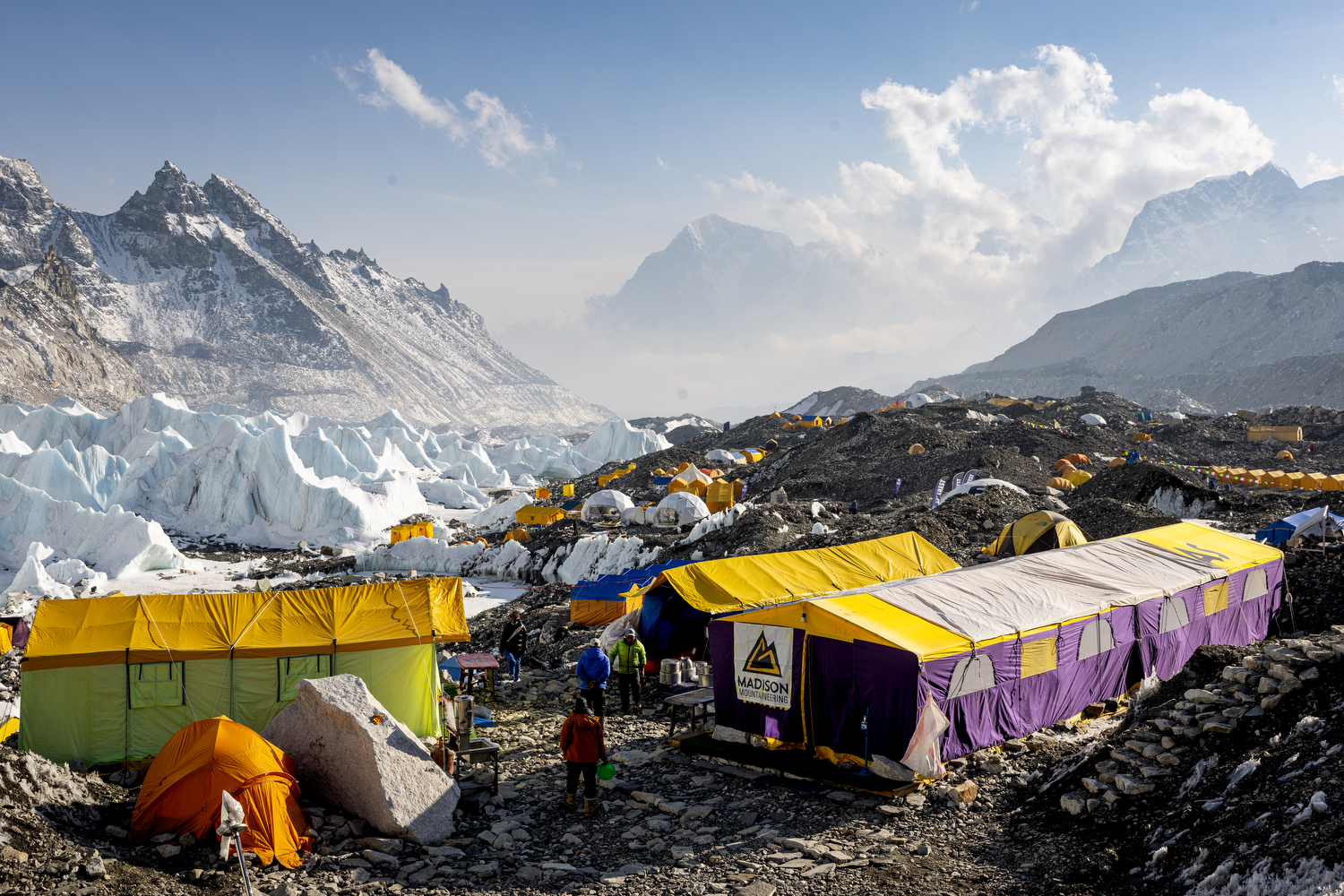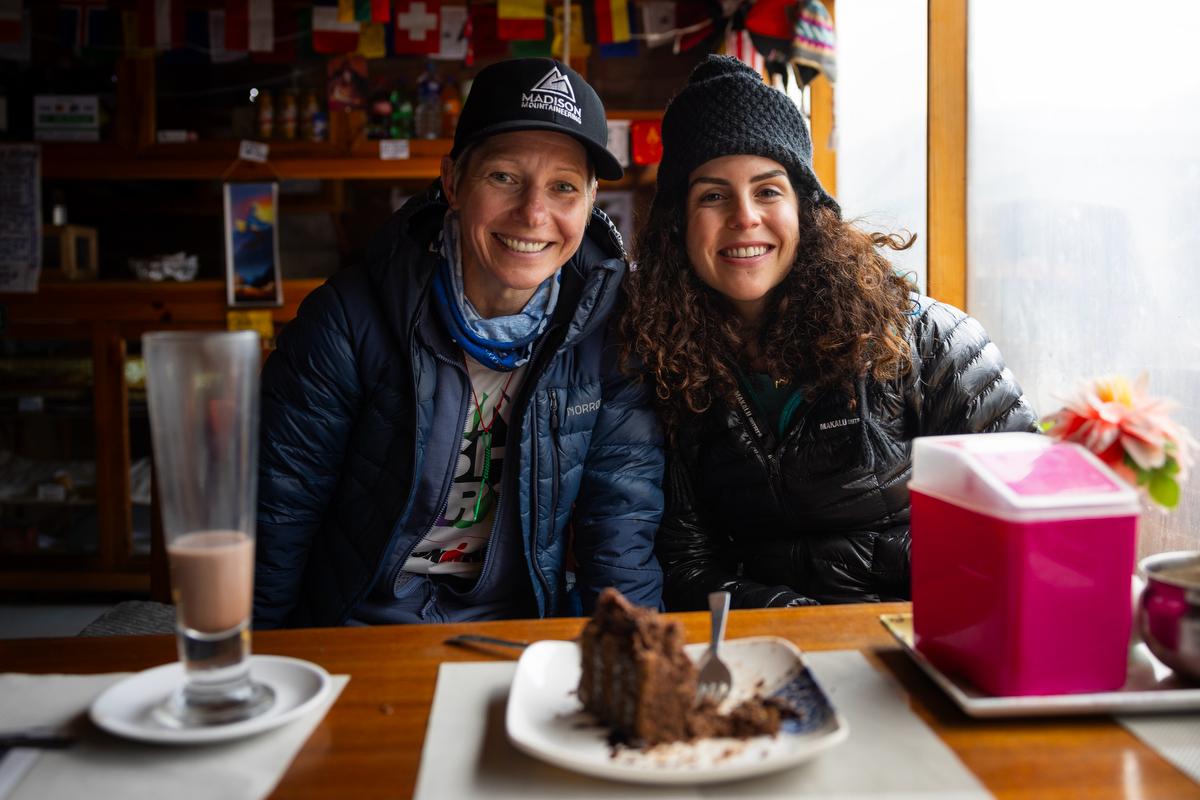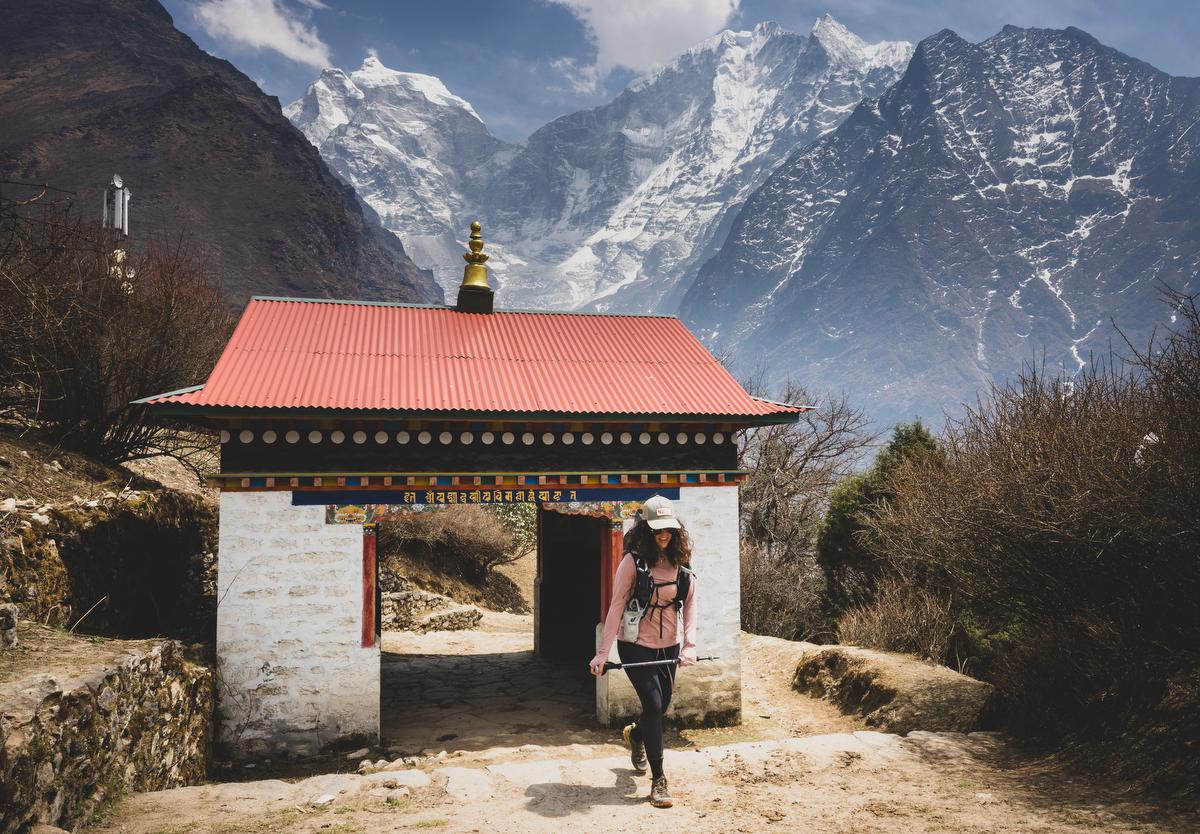Who is your guide? In addition to leading 24 previously successful expeditions of Mount Vinson, Garrett Madison has led 12 successful climbs of Mount Everest, 3 on K2, and many other expeditions around the globe. Garrett is a pleasant person to spend time with and is one of the best "expedition leaders" in balancing climber safety, reaching the summit, and having a great time throughout the program. Other Madison Mountaineering guides leading our teams on previous Mount Vinson seasons include Terray Sylvester, Conan Bliss, Ed Viesturs, and Conrad Anker!
Antarctic Journey
Our journey begins in the Tierra del Fuego (Spanish for “Land of Fire”) in Chile’s southernmost city of Punta Arenas, located on the strait of Magellan. A large statue of the famous explorer towers over the town square. Legend has it that those who kiss the statue are destined to return! After a briefing with our flight logistics operator we depart on a chartered jet and fly 4 hours over the Drake passage and then over a large part of the Antarctic continent, landing on a large strip of blue ice nearby the Union Glacier camp. We generally spend a day or two here making our expedition preparations and conducting skill training.Ski the last degree (111 km / 60 nautical miles) to reach the South Pole and experience the challenge and sense of discovery that the first explorers faced to reach the furthest point south. During this polar expedition you will be immersed in the vast beauty and tranquility of the high polar plateau and share the camaraderie of your team as you haul sleds and build camps on your way to the Pole. Antarctica’s interior is very dry, cold, and windy, with average temperatures around 17F (-8C), when the wind is not blowing the days can feel warm.
With the ‘physiological’ altitude approaching 11,000′ (3350m), we begin to build acclimatization during the week of skiing to the Pole.
Upon return to Union Glacier camp, we will spend a day further exploring the camp and practicing some snow and ice climbing techniques before flying via twin otter aircraft 45 minutes to Vinson Base Camp where be begin our climb.
Part of the Ellsworth mountain range, Mt. Vinson is the highest peak in Antarctica, approx. 600 miles from the South Pole and over 1,200 miles from the beginning of the Antarctic Peninsula. Traveling to Antarctica is an incredible experience in itself, as most Antarctic tourists merely catch a glimpse of the Antarctic peninsula from a cruise ship. Vinson climbers actually fly onto the continent (an opportunity normally only reserved for government funded scientists or support personnel) and experience the surreal environment of inland Antarctica. A pristine land of ice, snow, and rock, Antarctica is a desert, with the least precipitation of any continent on Earth. At our intermediate camp in Antarctica located on Union Glacier, we have the opportunity to interact with other Antarctic explorers as well as scientists doing meaningful research in their fields.
We break the ascent of Vinson into several stages. With two higher camps above our base camp, we can acclimate along the way and rest during the ascent. Most of the climbing is on glaciated slopes, with one full day on a steep snow and ice slope utilizing fixed ropes. The final day to the top involves climbing the summit ridge with amazing views of the surrounding peaks as well as looking to the horizon of ice as far as the eye can see.
Generally, we have stable weather during the climbing season of December and January, as this is the summer season in the southern hemisphere with 24 hours of daylight in Antarctica. The average temperature is well below 0°F and occasionally the winds can reach up to 40 mph.
Climbers should have experience climbing in cold conditions, be comfortable carrying a 40 lb. backpack, and possess appropriate glacier travel experience.
Program details
- Small team size, with a maximum of four climbers with one guide.
- Flexibility to adjust to changing mountain conditions, as well as possible flight delays.
- Expert leadership throughout, the highest success rate overall in the industry with top guides
- The best food on the mountain. Our team is famous for meals on Vinson that never disappoint! (think eggs, pancakes, and bacon for breakfast, meat, fish, with vegetables and a rice or potato dish for dinner)
- A dedicated and extremely knowledgeable contact person in the Madison Mountaineering office to assist with any pre-trip questions as well as logistics during and after the expedition
- Regular dispatches: Keep family members and friends informed through our daily dispatch from the mountain.
- Itinerary
- Dates and Costs
- Gear List
- Why Madison Mountaineering?
Day 1: Arrive in Punta Arenas, Chile. A representative with a Madison Mountaineering sign will meet you near the baggage claim area for transfer to the hotel. After settling in, we will conduct a thorough equipment check, and then have a group dinner at one of the many fine restaurants
Day 2: Pre-Departure Day. After breakfast, we attend a pre-flight briefing with our flight operator, and discuss many aspects of the journey to Antarctica. In the afternoon we send our duffel bags to the airport to be checked and packed for departure. We have the late afternoon and evening to explore the city.
Day 3: Pre-Flight Briefing. After breakfast we attend a pre-flight briefing with our flight operator and discuss many aspects of the journey to Antarctica. In the afternoon we send our duffel bags to the airport to be checked and packed for departure. We have the late afternoon and evening to explore the city
Day 4: Depart for Antarctica. We fly approximately 4 hours over the Drake Passage and land at Union Glacier camp. We generally spend 1-2 nights at this camp
Days 5-6: Expedition Preparations. You will spend a couple of days at Union Glacier to test your clothing and equipment and practice sled hauling on a mini-expedition outside of camp with your team. Then you’ll pack your sleds and ready for departure.
Day 7: Fly to 89°S. A ski plane will carry you from Union Glacier camp to 89°South, 111 km from the South Pole. Once there, the team will pack up the sleds and ski a short distance before setting up the first camp.
Days 8-12: Ski to the Pole. Each day you will ski a little longer as your body acclimatizes to the cold and the altitude. A typical day will be breakfast at 8am and pack and skiing by 10am. You will ski for about 1-hour with a 5-10-minute rest break before repeating until about 7pm when the team will stop, set up camp, and have dinner. In the final one or two days before reaching the South Pole, the Amundsen-Scott Station will come into view about 24 km away.
Day 13: Arrive at the Pole. You made it! Here at the South Pole the ice below you is nearly 3,000 meters thick. If time allows and staff from the United States Antarctic Program (USAP) are available, you will be given a tour of the Amundsen-Scott Station. You will camp overnight at the South Pole before the return flight to Union Glacier.
Day 14: Return to Union Glacier. The field staff will identify the window for best conditions for the return flight to Union Glacier. Depending on flights, a celebration dinner may be held at either the South Pole camp or at Union Glacier.
Day 15: Rest day to Union Glacier. Time for more exploring Union Glacier and review of snow and ice travel skills and techniques
Day 16: Expedition Training. Review rope travel, Ice axe arrest, and crevasse rescue techniques
Day 17: Fly to Vinson Base Camp. establish base camp
Day 18: Climb to Camp 1. establish camp
Day 19: Rest day at Camp 1. review fixed line climbing techniques
Day 20: Climb to Camp 2. establish camp
Day 21: Rest day at Camp 2. evaluate weather conditions for a summit attempt
Day 22: Summit day! We climb the glaciated slopes to the summit ridge, and then traverse the ridgeline to the highest point in Antarctica. Return to Camp 2 for the night
Day 23: Descend from Camp 2. to Vinson Base Camp, spend the night at VBC
Day 24: Fly back to Union Glacier Camp.
Day 25: Fly back to Punta Arenas. We plan to arrive back in Punta Arenas in the late evening.
Day 26: Sightseeing and preparations to return home from Punta Arenas.
Day 27: Depart Punta Arenas for home.
Days 28-33: Extra days in case of bad weather or flight delays – we strongly recommend booking a changeable return flight to accommodate any unexpected expedition itinerary delays.
Ski the last Degree & Climb Mount Vinson
- December 04 – 31, 2024
- December 15, 2024 – January 11, 2025
Deposit: USD 20,000
NOTE: The prices are based on fuel costs as of May, 2023. We reserve the right to revise our prices in the event of significant increases in the price of aviation kerosene and aircraft charter rates.
Costs Include:
- Round trip flights from Punta Arenas to Antarctica
- All flights within Antarctica to reach Vinson base camp and back
- All accommodation and services while in Antarctica
- All meals in Antarctica
- All team equipment (tents, ropes, cooking equipment, etc.)
- All communications equipment such as VHF radios and satellite phone
- Guide service fees
- Daily weather forecasting during the climb
Costs Do Not Include:
- Bank transfer fees, if needed
- Accommodation and meals in Punta Arenas
- Personal items (see equipment list)
- Medical and Evacuation Insurance (required)
- Trip cancellation insurance (highly recommended)
- Any charges incurred that are beyond the control of Madison Mountaineering
- All prices and program dates are subject to change
Cancellation/Refund Policy
- There are no refunds for the deposit or balance payments for this expedition. This includes but is not limited to, expeditions that conclude without reaching or making progress towards expedition objective(s) (for example, the summit) due to route conditions, weather, insufficient manpower, or any other factor outside the control of Madison Mountaineering.
- Expedition leader has the final say on the expedition conclusion and will make all best efforts towards reaching expedition objective(s) within our margin of safety.
- Participants that choose to leave an active expedition for any reason are not entitled to any refunds
- Madison Mountaineering, LLC highly recommends trip cancellation insurance for all expeditions
- Due to the nature and heavy costs of government and operator permits, Madison Mountaineering must adhere to a stringent refund policy
- Deposit due with registration materials
- All balances are due 120 days prior to departure date unless otherwise specified
- Participants whose balances are not received by the 120-day deadline as stated above, risk forfeiture of their funds and their place on the expedition
Note: Madison Mountaineering, LLC reserves the right to waive any fees. As we offer personalized service, we will attempt to accommodate changes and cancellations when necessary, waiving certain fees when feasible. Deposits paid by participants acknowledge the above cancellation terms.
Base Layers
- Synthetic Short Underwear (2-3 pair): non-cotton style underwear
- Lightweight Long Underwear (1-2 pair): long sleeve shirt and long pants
- Heavyweight Long Underwear (1 pair)
- Short Sleeve Synthetic Shirt (1-2)
Mid Layers
- Soft Shell Jacket: to be worn over other layers
- Soft Shell Pants: very breathable and water repellant
- Mid-Layer Top: lightweight layer for use over base layers
- Lightweight Nylon Pants (1-2 pair)
Windproof/Rain Layers
- Hard Shell Jacket with hood: waterproof and breathable shell jacket
- Hard Shell Pants: waterproof and breathable shell pants
Insulation Layers
- Heavyweight Insulated Down Jacket with hood
- Insulated Pants
Headwear
- Warm Hat: synthetic or wool hat (ski hat)
- Balaclava: to protect your neck and face in high winds
- Baseball Cap or other sun hat: to shade your face/neck from the sun on a hot day
- Bandana or Buff: to protect your neck/face from the sun
- Facemask: neoprene type
- Nose Guard (optional): sun protection for nose
Eyewear
- Glacier Glasses: full protection with side covers or wrap around
- Ski Goggles: to be worn in the event of high winds – (2nd pair optional)
Gloves
- Lightweight Synthetic Base Layer Gloves (2 pair): for wearing on warm days
- Soft Shell Gloves: to wear for moderate cold/wind
- Shell Glove with Insulated Liner: to wear for severe cold/strong wind
- Expedition Mitts: large enough to fit a liner glove inside
- Heated Gloves (optional): battery-powered heated gloves
Footwear
- Liner Socks (3 pairs)
- Wool or Synthetic Socks (3 pairs)
- Mountaineering Boots
- Camp Boots: warm comfortable boots for wearing in camp
- Booties (optional)
Sleeping Equipment
- Sleeping Bag: rated to at least -40°F
- Self-inflating Sleeping Pad: full length is preferred
- Closed-cell Foam Pad: to be used in conjunction with the inflating pad for warmth and comfort when sleeping
- Earplugs
Mountaineering Gear
- Expedition Backpack: approximately 105L
- Compression Stuff Sacks: for reducing the volume of the sleeping bag, down parka, etc. in your pack
- Trash Compactor Bags: to line backpack and stuff sacks as well as for separating gear
- Trekking Poles with Snow Baskets: adjustable
- Ice Axe: general mountaineering tool (65cm)
- Ice Axe Leash: harness style, not wrist style
- Crampons: general mountaineering crampons
- Climbing Helmet: must be able to fit over your warm hat
- Ascender: 1 right or left-hand ascender
- “Y” Rig for ascender and safety carabiner
- Accessory Cord: 30 feet (9m) of 6mm accessory cord
- Alpine Climbing Harness: mountaineering harness, with adjustable leg loops. Not a rock-climbing “sport” harness
- Carabineers: 4 regular, 2 standard locking, 2 large locking for use with harness
- Belay/Rappel Device
- Sled Duffle Bag: 150L expedition duffel bag used to transport all gear on your sled; must be waterproof and durable
Travel Items
- Small Duffel Bag with Lock: to store items in the hotel(s) while on the climb
- Carry-on Backpack: approximately 18” x 16” x 10” (46cm x 41cm x 26cm)
- Travel Clothes and Shoes: for days in cities and towns
- Lightweight journal, sketchbook, pencils, pen
- U.S. cash: for currency exchange to purchase SIM cards or merchandise in cities and towns
Additional Food Items
- Snack food: bring a few days’ supply of your favorite climbing snack food such as bars, gels, nuts, beef jerky, etc. variety of salty and sweet is good
Other Equipment
- Cup: plastic 16 oz. minimum cup or mug
- Bowl: large plastic bowl for eating dinner or breakfast
- Spoon: plastic spoon (Lexan)
- Water Bottles (2 or 3): wide mouth bottles with 1-liter capacity
- Water Bottle Parkas (2): fully insulated with zip opening
- Thermos: 1 liter
- Hand and Toe Warmers
- Heated Insoles (optional)
- Sunscreen: SPF 50 or better
- Lip Screen (2 sticks): SPF 30 or better
- Toiletry Bag: include 2 rolls of toilet paper stored in ziplock bags, hand sanitizer, toothbrush, toothpaste, floss, and wet wipes
- Pee Bottle: 1-liter minimum bottle for convenience at night in the tent
- Female Urination Device (FUD)
- Knife or Multi-tool: keep it simple
- Small Personal First-aid Kit: include pain killers, athletic tape, band-aids, Ibuprofen, blister care, cough drops, etc.
- Medications and Prescriptions: bring antibiotics (Azithromycin, etc.), and altitude medicine such as Diamox and dexamethasone
- Handkerchiefs/Bandanas (optional)
Optional Electronics
- Country-appropriate power plug adapters and power transformers
- Avalanche Transceiver
- Adventure Sports Watch: such as Garmin fēnix 6
- GPS/Personal Satellite Communicator: such as Garmin inReach Mini
- Personal Power System: such as Goal Zero Nomad 28 Plus Solar Panel and Sherpa 100AC Power Bank
- Digital Entertainment: movies, tv shows, music, books loaded on to smartphone, iPad, Kindle
- Camera: bring extra batteries, charger, and memory cards
Madison Mountaineering is recognized for well thought out strategy in leading high altitude climbing expeditions, as well as high-quality service throughout. We have two decades of experience in the planning and coordination of mountaineering expeditions, our reputation is excellent. We strive to make each expedition the best possible experience for our climbers and focus on our 3 primary goals of success in reaching the summit, returning safely, and having fun! Safety is always our number one priority.
Our guides are some of the best and most experienced in the industry, having a strong grasp of technical climbing, expedition, and high altitude experience, along with strong interpersonal skills. Our teams are small and equipped with the best support available to ensure the highest chance of success. We are renowned for our comfortable base camps, high-quality food, first-rate communications, and medical support services, all of which are overseen by a professional member of our team.
Most of our climbers have either climbed with us before, been referred by a friend who has climbed with us, or met one of our teams while attempting another peak and decided to join us for their next expedition. We work hard to facilitate safe, successful, and enjoyable expeditions for all of our climbers. Our track record and past climber testimonials prove we are highly competent experts in our field and love what we do!
